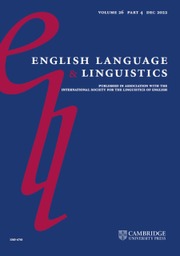Article contents
‘Flip-flop’ and mergers-in-progress1
Published online by Cambridge University Press: 10 June 2013
Abstract
During a merger-in-progress, occasionally one or two speakers will exhibit an unusual phonological pattern reminiscent of flip-flop (Labov et al. 1972). In such cases, the merging vowels appear to move past the point of coalescence in at least one phonetic dimension; difference is maintained but the vowel quality is opposite to the historical pattern on one or both dimensions. Flip-flop between the cot and caught vowels occurs for two speakers in a recent sample from San Francisco, California. The community shows robust change in progress toward a lower and fronter caught vowel nucleus, and no change in apparent time for cot. Further analysis shows that this is leading to a change in apparent time toward merger, and that the rate of vowel convergence is stronger among Chinese Americans than European Americans. The two speakers who produce flip-flop are seen to represent a key transitional generation with respect to the ethnic identity of the neighborhood, where flip-flop may be but one linguistic consequence of a lifetime of active negotiation between conflicting local meanings. The analysis suggests that ethnographic detail and attention to individual outliers allows for more comprehensive models of the range of phenomena associated with vowel mergers.
Information
- Type
- Research Article
- Information
- English Language & Linguistics , Volume 17 , Issue 2: Phonological mergers in English , July 2013 , pp. 359 - 390
- Copyright
- Copyright © Cambridge University Press 2013
Footnotes
The first version of this work was presented at the International Society for the Linguistics of English (ISLE), in June 2011, on the panel ‘Mergers in English: perspectives from phonology, sociolinguistics and psycholinguistics’, organized by Lynn Clark, Warren Maguire and Kevin Watson. I extend my thanks to them for organizing the workshop and this special issue. A second version was presented at the Department of Linguistics at Queen Mary, University of London, in January 2012, and I thank that audience for their valuable feedback. I am indebted to the anonymous reviewers of this paper for their detailed and insightful observations. Thanks to Jennifer Nycz, Kevin Stadler, Helen West and Amy Wong for useful discussions. The speakers whose voices are analyzed here receive my greatest debt of gratitude.
References
- 41
- Cited by

